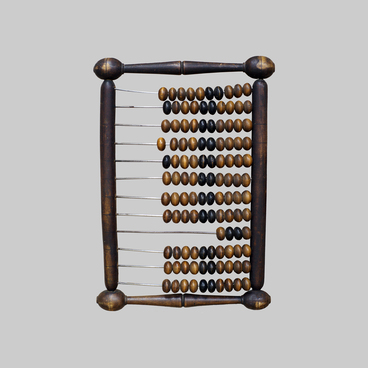The millstone was submitted to the museum in 1926 when an archaeological expedition concluded the excavations at the settlement of Dondykar that dates back to the 9th–12th centuries. The work of the expedition in 1926–1927 was supervised by Soviet historian and archaeologist Alexey Smirnov, a specialist in the field of Finno-Ugric and Bulgar archaeology, and professor at Moscow State University.
The settlement was located on a promontory about 10 meters high and was fortified with a small rampart. Remains of 19 domiciles were unearthed during the excavations: workshops, sheds, and hearths. Many items of Tsepets culture were unearthed and gathered for research purposes.
The round millstone is made from limestone and has a round hole in the center. One working side is flat, while the other is rough. The millstones were used for grinding grains and making flour.
The millstone has been used by mankind since the ancient times of the Neolithic era. Some historians suggest that it was invented before the wheel was. Russian word for ‘millstone, ’ ‘zhernov, ’ derives from the Proto-Slavic ‘жърнъве’. That word used to mean ‘heavy.’ A similarly sounding word for millstone is also present in Ukrainian, Belorussian, and Czech languages.
The word has a literal and a figurative meaning in the Russian language. ‘Zhernovs’ (‘millstones’) can mean ‘the fatal, cruel and merciless circumstances a person faces.’ If we consider the millstone a labor tool, then we are talking about a pair of circles, usually made from stone.
The millstones were used to grind grain crops, nuts, and roots. The grains, falling into the opposing grooves of two stone blocks, were crushed into smaller particles, and so the grain was ground. The following riddle has been composed about the millstone and the product it used to produce: ‘The stone sea is spinning around, the white hare lies down beside it, and everyone has a use for it’.
Millstones used to be common household items. The stone millstones were set in motion with a special cruciform pin mounted on a vertical wooden rod. Both millstones had to be aligned and adjusted to each other — this was crucial for the operation of the device. Poorly balanced millstones will produce poorly ground flour. Millstones were commonly made from limestone or fine-grained sandstone. The material for the millstone had to be hard and tough.
The settlement was located on a promontory about 10 meters high and was fortified with a small rampart. Remains of 19 domiciles were unearthed during the excavations: workshops, sheds, and hearths. Many items of Tsepets culture were unearthed and gathered for research purposes.
The round millstone is made from limestone and has a round hole in the center. One working side is flat, while the other is rough. The millstones were used for grinding grains and making flour.
The millstone has been used by mankind since the ancient times of the Neolithic era. Some historians suggest that it was invented before the wheel was. Russian word for ‘millstone, ’ ‘zhernov, ’ derives from the Proto-Slavic ‘жърнъве’. That word used to mean ‘heavy.’ A similarly sounding word for millstone is also present in Ukrainian, Belorussian, and Czech languages.
The word has a literal and a figurative meaning in the Russian language. ‘Zhernovs’ (‘millstones’) can mean ‘the fatal, cruel and merciless circumstances a person faces.’ If we consider the millstone a labor tool, then we are talking about a pair of circles, usually made from stone.
The millstones were used to grind grain crops, nuts, and roots. The grains, falling into the opposing grooves of two stone blocks, were crushed into smaller particles, and so the grain was ground. The following riddle has been composed about the millstone and the product it used to produce: ‘The stone sea is spinning around, the white hare lies down beside it, and everyone has a use for it’.
Millstones used to be common household items. The stone millstones were set in motion with a special cruciform pin mounted on a vertical wooden rod. Both millstones had to be aligned and adjusted to each other — this was crucial for the operation of the device. Poorly balanced millstones will produce poorly ground flour. Millstones were commonly made from limestone or fine-grained sandstone. The material for the millstone had to be hard and tough.



